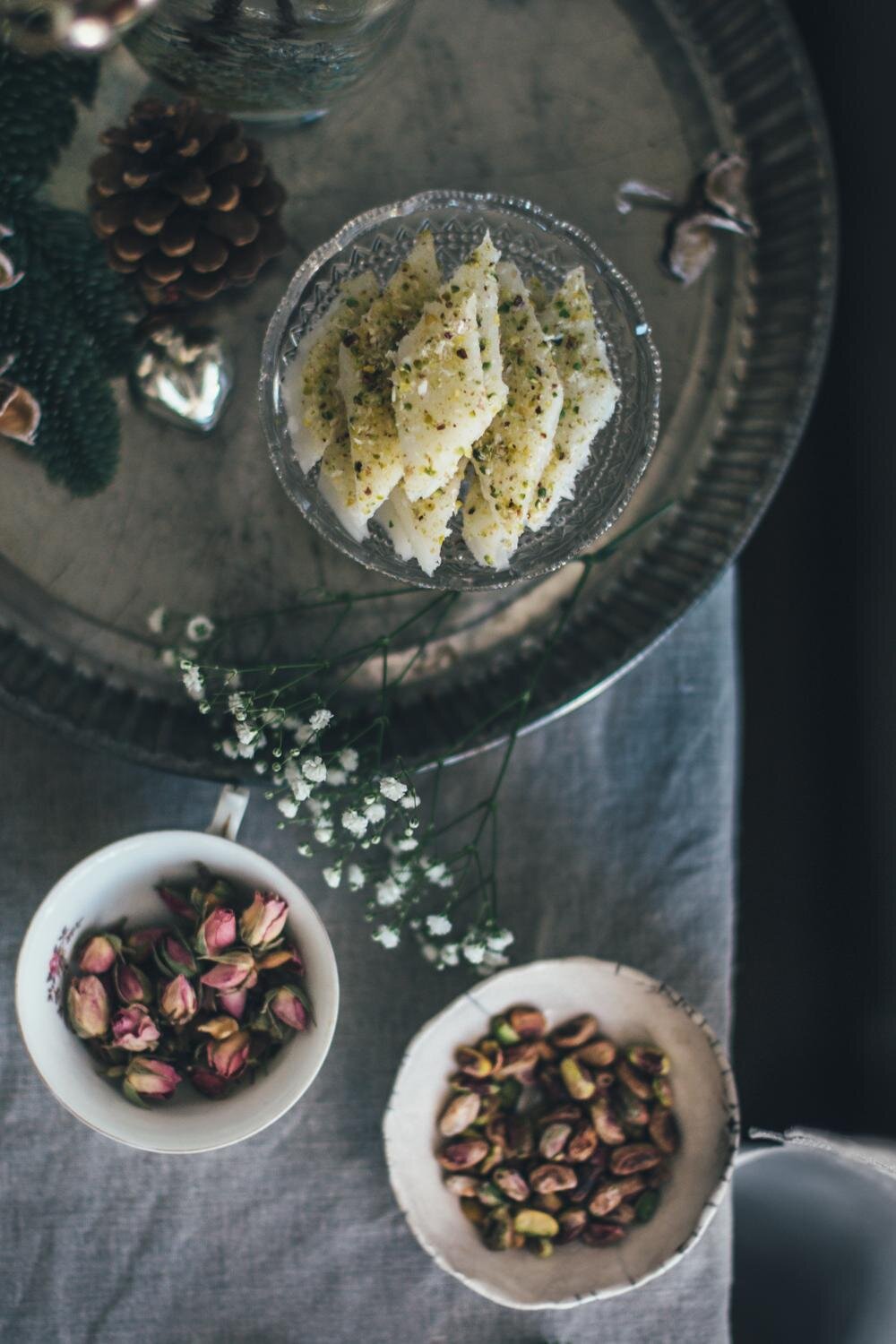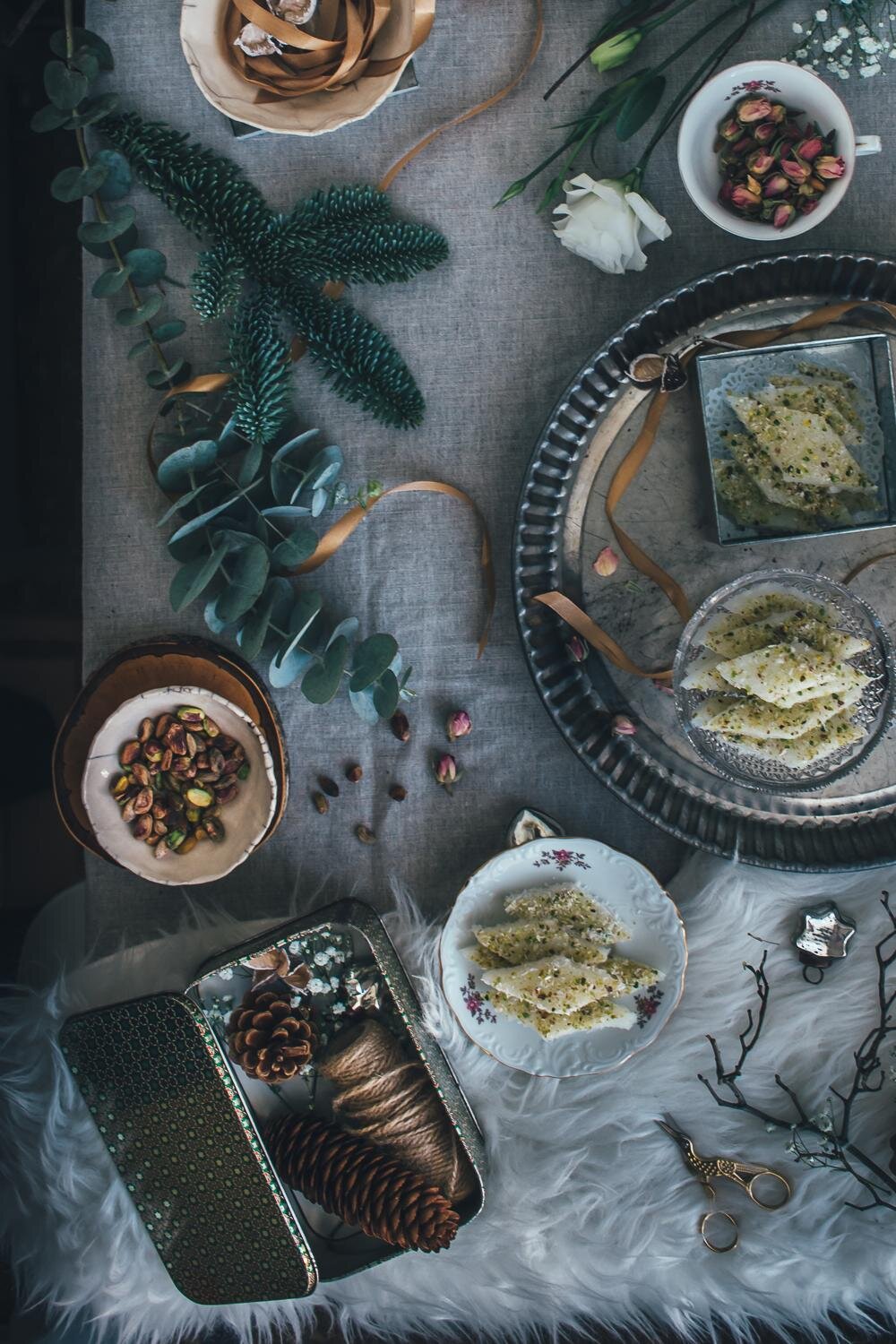Turkish Delight as Christmas Edible Gifts from the East
I. Christmas Flavors from the East
Would a Christmas with Middle Eastern flavors sound outrageous or alternative to you? What if I told you that your Christmas at times — tastes and smells like the feasts and celebrations of the East, and it has been so for centuries? Warm spices such as cinnamon, ginger, nutmeg and cloves that evoke the spirit of Christmas, form the flavor pallet of so many ancient and modern Middle Eastern recipes. Many roast or braised meats that we serve on Christmas are enriched with dried fruits such as raisins, plums, dates and apricots; a normality in many dishes from the East.
Winter feasts, regardless of their location or origin, celebrate togetherness in order to survive the dark. There’s often dry fruits and nuts in the festive dishes, mainly because fresh fruit was not available in the cold season. In the medieval ages spices, figs, dates, nuts, turkish delights, and even sugar were luxury goods that were imported to Europe from the Middle and Far East. So naturally, they were consumed in banquets and feasts. The medieval Christmas has left a footprint of Middle Eastern flavors in the Christmas dishes of northern Europe, and consequently, North America and Oceania. As for Italy, apart from Sicily, Naples and other Southern parts where the dominations have permanently inserted some Middle Eastern flavors to many dishes, the rest of the country does Christmas with little or no warm spices.
If you’ve followed this blog for a long time, you might remember that in Iran we don’t celebrate Christmas, but we do celebrate Yalda, a celebration of the Winter Soltice. Although Yalda is a laic festival based on ancient seasonal traditions, it is similar in some ways to Christmas, which I talked about in details here. Eating nuts, dry fruits and Turkish Delights is one of these similarities.
One of the sweets that we always serve on the Yalda table along with nuts, pomegranates and —oddly enough— watermelon, is Baslogh. Also known as Lokum, Rahat Lokum (راحة الحلقوم) or more commonly, the Turkish Delights. The Turkish-ness of these sweet, gooey, soft and fragrant candies however can open a never ending debate. They are common in all the Balkan region and the Middle East, and we must admit that choosing the name Turkish Delight has been an incredibly clever marketing tactic, that has opened the way of these festive sweets into the western shops and even literature.
Turkish Delights are featured in the Chronicles of Narnia, as a sweet temptation of an evil witch that uses them to get information from a boy who loves the candies. The amazing Diana Henry (food writer and author of many books) on a podcast on Channel 4 Food Programme digs deep into the Eastern flavors for Christmas celebrations and a very interesting part of the podcast is dedicated to Turkish Delights.
II. Persian Delights: More Delicate, Easy Turkish Delights
No matter the name, these rose scented candies have been present all this Holiday season in my kitchen, beside my tea, all over my apron, in my travels and also in my cooking events! I knew I wanted to make a blog post about them as an edible Christmas Gift (my type of gift, remember this post?), as well as making them for the Christmas Pop up Kitchen we held on December 18th at Latteria Studio. Last weekend I went to Milan to make these Persian Delights with Alice aka A Gipsy in the Kitchen and we filmed it live on Facebook(in Italian). This post is my contribute to the virtual Yalda Celebration of the Persian Food Bloggers, so do check out other Iranian recipes for the festive season at the bottom of this post.
There really is something fairy tale-ish about these sweets. They’re incredibly soft, yet they have a satisfying texture too. My version of this recipe is super delicate, as I have reduced the sugar amount. After many tries (including some embarrassing failures), I finally realized how to perfect the gummy effect by using a lot of gelatin sheets. The key is to use the double dose of gelatin for the amount of water in the indications, as we’re making a solid candy, not a jelly to be eaten by the spoon.
The rose water is a staple, the Lokum must be so rosy to make you think you’re eating a smell, but you could substitute it with orange blossom or other food fragrance if you want. Do stay away from chemical food coloring though, a white Persian Delight will be pretty all the same.
Now let me wish a warm and Merry Christmas, a happy Yalda and a serene Hanukkah. Hope you can share some quality time and good food with your loved ones. Do use these holidays to recharge your batteries, and don’t stress it.
Enjoy!
Persian Delights, Rosy Candies as Edible Christmas Gifts
INGREDIENTS
1 cup (130-150g) cornflour (corn starch)
2 cups (450g) caster sugar
1 1/2 cup (350ml) + 1/2 cup (120ml) water
8 sheets of gelatine*
1/2 tsp tartar cream
1 tbsp good quality rose water
granulated pistachios for garnish
coconut flour + all purpose flour for garnish and keeping candies seperated
INSTRUCTIONS
Grease a plum cake tin and set aside.
In a pot, melt the sugar with 1/2 cup (120ml) water. Put on a medium-low flame until sugar dissolves, the liquid becomes transparent, boils and thickens enough so that it wouldn't run down a spoon immediately.
Soak the gelatine sheets in a bowl of cold water as indicated on the packaging.
In another larger pot melt the starch with 1 1/2 cup (350ml) of water and mix well until no lump left. Add the tartar cream, put on a medium-low flame and keep whisking until lumps appear in the liquid and it starts to thicken. Keep whisking/turning the liquid in order to not let it make lumps, lower the flame and never let it come to boil.
Gradually add the sugar syrup to the starch mix and whisk well. Add the Rosewater.
Squeeze each gelatine sheet off its excess water and add to the mixture, again whisking vigorously. Let the candy mixture thicken for a couple more minutes after adding the gelatine.
Pour the candy mixture in the plum cake tin. Make sure the surface is even. Sprinkle some pistachio powder and coconut flower on top.
Let it cool down and then fridge for at least 4 hours.
Prepare a clean working surface. Cover it with some flour and coconut flour. In a large blow mix some coconut flour and all purpose flour (or corn starch).
Very carefully, and starting at the edges, remove the candy base from tin and place it top down on the working surface.
With a very sharp knife, cut the Persian delight into cubes. In order to get clean, easy cuts, cover the knife with flours from the bowl before each new cut.
Put a dozen of candies at a time in the bowl of flour and coconut flour, shake the bowl until all the surfaces of the candies is cover with mixtures and is no longer wet.
If boxing the Persian Delight candies, it better if you add some flower mixture in the bottom of the box too, so that the candies would not stick to the box.
Serve with black tea or coffee.
NOTES
*The gelatine I used indicated 6 sheets for a total amount of 500ml of water. So in order to get thick candies, I used 8 sheets for a total of 480/500ml of water. You could use even 10.

















